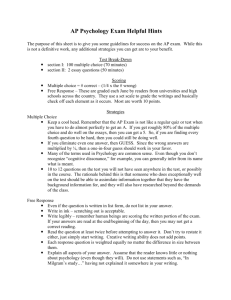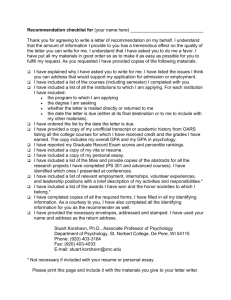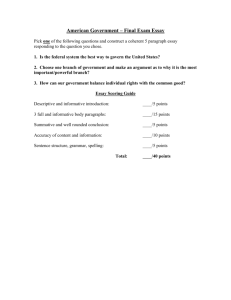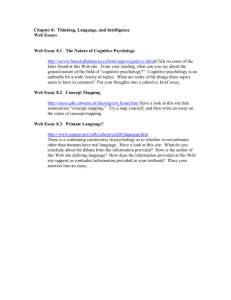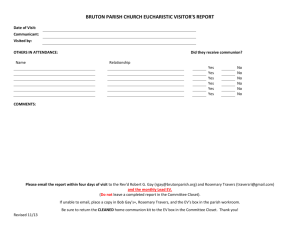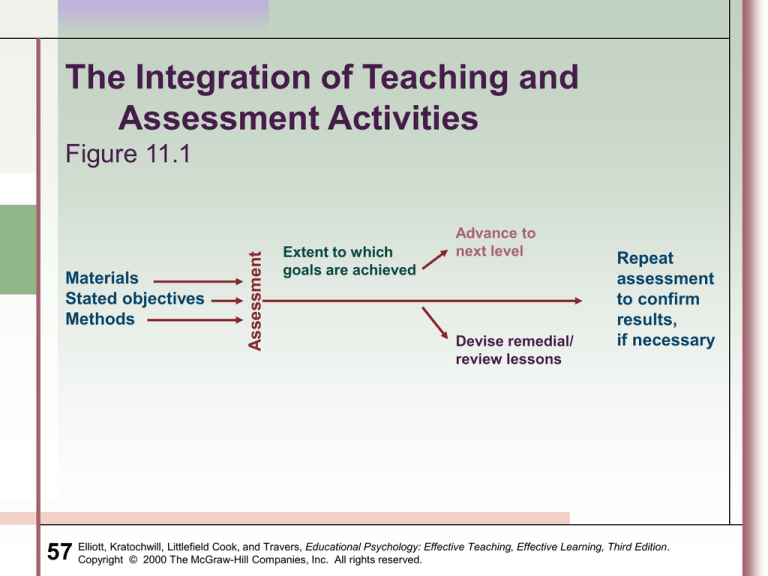
The Integration of Teaching and
Assessment Activities
Materials
Stated objectives
Methods
Assessment
Figure 11.1
Extent to which
goals are achieved
Advance to
next level
Devise remedial/
review lessons
Repeat
assessment
to confirm
results,
if necessary
Kratochwill, Littlefield Cook, and Travers, Educational Psychology: Effective Teaching, Effective Learning, Third Edition.
57 Elliott,
Copyright © 2000 The McGraw-Hill Companies, Inc. All rights reserved.
Spelling: Scoring Criteria and Standards
Figure 11.3
Accuracy
(0-1)
0 = incorrect spelling
1 = correct spelling
Exemplary 90–100%, Satisfactory 70–89%, Inadequate 0–69%
Usage
(0-2)
0 = not used or used incorrectly
1 = acceptable basic use
2 = elaborative use (enriched vocabulary and language
use, adjectives, etc.)
Example: ate
(0) He had ate books.
(1) My dog ate his food.
(2) She ate the delicious meal her father prepared.
Exemplary 90–100%, Satisfactory 50–89%, Inadequate 0–49%
Punctuation
(0-3)
0 = no beginning capital letter or ending mark
1 = either beginning OR ending
2 = both beginning and ending
3 = both, plus additional punctuation (quotation marks,
commas, etc.)
Exemplary 90–100%, Satisfactory 67–89%, Inadequate 0–66%
Legibility
(0-2)
0 = generally illegible (majority)
1 = acceptable
2 = cursive, no trace overs
Exemplary 90–100%, Satisfactory 50–89%, Inadequate 0–49%
Kratochwill, Littlefield Cook, and Travers, Educational Psychology: Effective Teaching, Effective Learning, Third Edition.
58 Elliott,
Copyright © 2000 The McGraw-Hill Companies, Inc. All rights reserved.
Analytic Scoring Criteria for a Written
Communication
Figure 11.7
CRITERIA FOR ANALYTICAL SCORING
3
4
5
SENT. STR. ORGANIZATION
2
Little or nothing is written.
The essay is disorganized,
incoherent, and poorly
developed. The essay does
not stay on the topic.
The essay is not complete.
It lacks an introduction,
well-developed body or
conclusion. The coherence
and sequence are attempted,
but not adequate.
The essay is well-organized.
It contains an introductory,
supporting, and concluding
paragraph. The essay is
coherent, ordered logically,
and fully developed.
The student writes frequent
run-ons or fragments.
The student makes
occasional errors in
sentence structure. Little
variety in sentence length
or structure exists.
The sentences are complete
and varied in length and
structure.
USAGE
1
The student makes frequent
errors in word choice and
agreement.
The student makes
occasional errors in word
choice or agreement.
The usage is correct. Word
choice is appropriate.
From Adams County School District #12, 11285 Highline Dr., Northglenn, CO 80203.
Kratochwill, Littlefield Cook, and Travers, Educational Psychology: Effective Teaching, Effective Learning, Third Edition.
59 Elliott,
Copyright © 2000 The McGraw-Hill Companies, Inc. All rights reserved.
Analytic Scoring Criteria for a Written
Communication
Figure 11.7 (Continued)
CRITERIA FOR ANALYTICAL SCORING
3
4
5
MECHANICS
2
The student makes
frequent errors in spelling,
punctuation, and
capitalization.
The student makes an
occasional error in
mechanics.
The spelling, capitalization,
and punctuation are correct.
FORMAT
1
The format is sloppy.
There are no margins or
indentations. Handwriting
is inconsistent.
The handwriting, margins,
and indentations have
occasional inconsistencies no title or inappropriate title.
The format is correct. The
title is appropriate. The
handwriting, margins, and
indentations are consistent.
From Adams County School District #12, 11285 Highline Dr., Northglenn, CO 80203.
Kratochwill, Littlefield Cook, and Travers, Educational Psychology: Effective Teaching, Effective Learning, Third Edition.
60 Elliott,
Copyright © 2000 The McGraw-Hill Companies, Inc. All rights reserved.
Portfolios
Figure 11.8
Painting PORTRAITS with PORTFOLIOS
Look for patterns which allow you to discover…
•
•
•
•
•
•
•
•
•
•
•
•
what students are attempting to achieve
if students are being successful
what changes students may need to make
what students have learned
how students view learning
how students approach learning
what skills and strategies students use
what kind(s) of judgments students make
what type(s) of learning students value
what expectations exist for future learning
what conditions enhance learning
what instructional factors influence or alter learning
You may also discover clues as to students’...
•
•
•
•
interests
persistence
cooperativeness
confidence
•
•
•
•
habits
• independence
curiosity
• creativeness
initiative
willingness to take risks
Kratochwill, Littlefield Cook, and Travers, Educational Psychology: Effective Teaching, Effective Learning, Third Edition.
61 Elliott,
Copyright © 2000 The McGraw-Hill Companies, Inc. All rights reserved.
Comparison of Teacher-Constructed and
Standardized Tests
Standardized
Achievement Tests
Teacher Constructed
Achievement Tests
Learning outcomes and
content measured
Measure outcomes and content
common to majority of U.S. schools.
Tests of basic skills and complex
outcomes adaptable to many local
situations; content-oriented tests
seldom reflect emphasis or
timeliness of local curriculum.
Well adapted to outcomes and content of
local curriculum. Flexibility affords continuous adaptation of measurement to
new materials and changes in procedure.
Adaptable to various-sized work units. Tend
to neglect complex learning outcomes.
Quality of test items
General quality of items high.
Written by specialists, pretested,
and selected on basis of
effectiveness.
Quality of items unknown unless test item
file is used. Quality typically lower than
that of standardized because of teacher’s
limited time and skill.
Reliability
Reliability high, commonly between
.80 and .95; frequently above .90.
Reliability usually unknown; can be high
if carefully constructed.
Administration and
scoring
Procedures standardized; specific
instructions provided.
Uniform procedures favored but may be
flexible.
Interpretation of
scores
Scores can be compared with those
of norm groups. Test manual and
other guides aid interpretation
and use.
Score comparisons and interpretations
limited to local school situation.
Table 11.1
Reprinted with the permission of Simon & Schuster, Inc. from the Macmillan College text Measurement and Evaluation in Teaching, 7th ed. by
Norman E. Gronlund and Robert L. Linn. Copyright © 1995 by Macmillan College Publishing Company.
Kratochwill, Littlefield Cook, and Travers, Educational Psychology: Effective Teaching, Effective Learning, Third Edition.
62 Elliott,
Copyright © 2000 The McGraw-Hill Companies, Inc. All rights reserved.
The Employability Skills Profile for
Organizing Portfolio Skills
Table 11.6
Academic Skills
Read and understand written
materials
Understand charts and graphs
Understand basic math
Use mathematics to solve
problems
Use research and library skills
Use specialized knowledge and
skills to get a job done
Use tools and equipment
Speak in the language in which
business is conducted
Write in the language in which
business is conducted
Use scientific method to solve
problems
Personal Management
Skills
Teamwork Skills
Attend school/work daily and
on time
Meet school/work deadlines
Develop career plans
Know personal strengths and
weaknesses
Demonstrate self-control
Pay attention to details
Follow written and oral instructions
Follow written and oral directions
Work without supervision
Learn new skills
Identify and suggest new ways to
get the job done
Actively participate in a group
Know the group’s rules and values
Listen to other group members
Express ideas to other group
members
Be sensitive to the group members’
ideas and views
Be willing to compromise if
necessary to best accomplish the
goal
Be a leader or a follower to best
accomplish the goal
Work in changing settings and with
people of differing backgrounds
From Stemmer et al. (1992). Educational Leadership, 49, 78-81. (pub. ASCD).
Kratochwill, Littlefield Cook, and Travers, Educational Psychology: Effective Teaching, Effective Learning, Third Edition.
63 Elliott,
Copyright © 2000 The McGraw-Hill Companies, Inc. All rights reserved.
Comparison of Various Types of
Assessment
Table 11.7
Purpose
Objective Test
Sample knowledge
with maximum
efficiency and
reliability
Typical exercise Test items:
Essay Test
Performance
Oral Question Assessment
Assess thinking skills
and/or mastery of a
structure of
knowledge
Assess knowledge Assess ability to translate
during instruction knowledge and
understanding into
action
Writing task
Open-ended
question
Written prompt or
natural event framing
the kind of performance
required
Multiple-choice
True/false
Fill-in
Matching
Student’s
response
Read, evaluate,
select
Organize, compose
Oral answer
Plan, construct, and
deliver original response
Scoring
Count correct
answers
Judge understanding
Determine
correctness of
answer
Check attributes present,
rate proficiency
demonstrated, or
describe performance via
anecdote
From: R.J. Stiggins, “Design and Development of Performance Assessments,” EDUCATIONAL MEASUREMENT: ISSUES AND PRACTICE, 1987 6,3,
p. 35. Copyright © 1987 by National Council on Measurement in Education. Reprinted by permission of the publisher.
Kratochwill, Littlefield Cook, and Travers, Educational Psychology: Effective Teaching, Effective Learning, Third Edition.
64 Elliott,
Copyright © 2000 The McGraw-Hill Companies, Inc. All rights reserved.
Comparison of Various Types of
Assessment
Table 11.7 (Continued)
Major advantage
Objective Test
Essay Test
Efficiency—can
administer many
items per unit of
testing time
Can measure complex Joins assessment Provides rich evidence
cognitive outcomes
and instruction
of performance skills
Potential sources Poorly written items,
overemphasis on
of inaccurate
recall of facts, poor
assessment
test-taking skills,
failure to sample
content representatively
Influence on
learning
Performance
Oral Question Assessment
Overemphasis on
recall encourages
memorization; can
encourage thinking
skills if properly
constructed
Poorly written
exercises, writing
skill confounded with
knowledge of content, poor scoring
procedures
Poor questions,
students’ lack of
willingness to
respond, too few
questions
Poor exercises, too few
samples of performance,
vague criteria, poor
rating procedures, poor
test conditions
Encourages thinking
and development of
writing skills
Stimulates
Emphasizes use or availparticipation in
able skill and knowledge
instruction, proin relevant problem
vides teacher
contexts
immediate feedback on effectiveness of teaching
From: R.J. Stiggins, “Design and Development of Performance Assessments,” EDUCATIONAL MEASUREMENT: ISSUES AND PRACTICE, 1987 6,3,
p. 35. Copyright © 1987 by National Council on Measurement in Education. Reprinted by permission of the publisher.
Kratochwill, Littlefield Cook, and Travers, Educational Psychology: Effective Teaching, Effective Learning, Third Edition.
65 Elliott,
Copyright © 2000 The McGraw-Hill Companies, Inc. All rights reserved.
Comparison of Various Types of
Assessment
Table 11.7 (Continued)
Objective Test
Keys to success Clear test blueprint
or specifications
that match instruction, skill in item
writing, time to
write items
Essay Test
Carefully prepared
writing exercises,
preparation of model
answers, time to read
and score
Oral Question
Clear questions,
representative
sample of questions
to each student,
adequate time provided for student
response
Performance
Assessment
Carefully prepared
performance exercises;
clear performance
expectations; careful,
thoughtful rating; time
to rate performance
From: R.J. Stiggins, “Design and Development of Performance Assessments,” EDUCATIONAL MEASUREMENT: ISSUES AND PRACTICE, 1987 6,3,
p. 35. Copyright © 1987 by National Council on Measurement in Education. Reprinted by permission of the publisher.
Kratochwill, Littlefield Cook, and Travers, Educational Psychology: Effective Teaching, Effective Learning, Third Edition.
66 Elliott,
Copyright © 2000 The McGraw-Hill Companies, Inc. All rights reserved.

